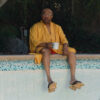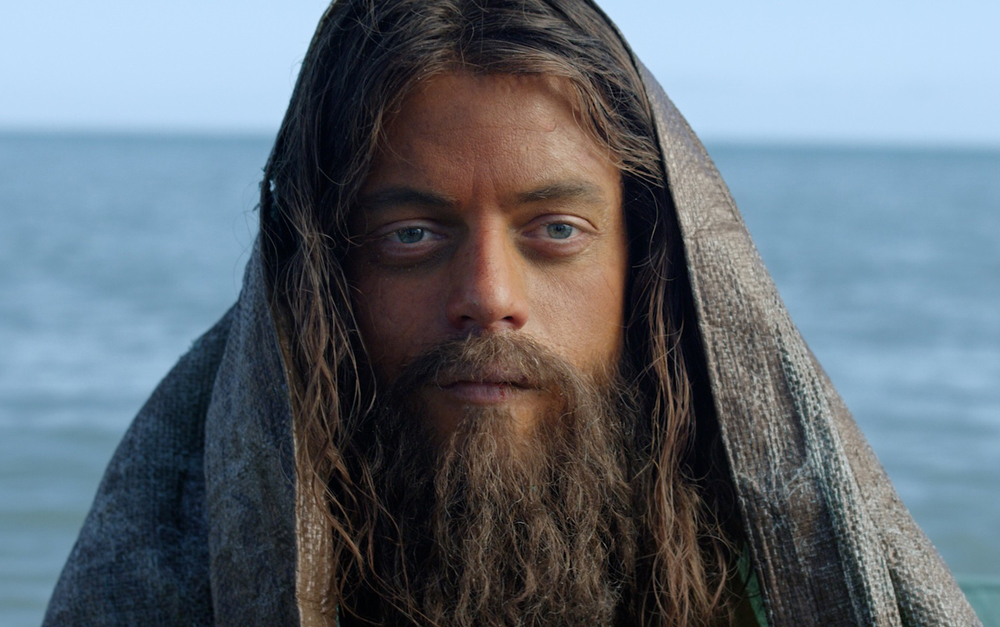“Sometimes I do this to myself…” Sarah Adina Smith, the writer/director, starts to confess about her filmmaking process. “I like to shoot the hardest stuff first, almost as a way of showing myself and the crew that if we can scale this first mountain, we can scale all of them.”
For most filmmakers, this might sound like a metaphor, but in the case of Smith’s second film “Buster’s Mal Heart” it was quite literal — though actually, the mountains only came after a turbulent two-day shoot on the open water. To listen to Smith talk about making movies, one can hear the way the great explorers spoke of setting foot on undiscovered territory, with the description of the practicality and logistics of such a challenging undertaking as if it was a pittance for the thrill of the adventure.
Once a painter who found even the biggest of canvases too small for her imagination, Smith has, in just two films, carved out a unique place in cinema, forging a compelling filmography about our engagement with the natural world, first delving into the mysteries held by a lake as a trio of sisters return home to investigate their mother’s drowning death in “The Midnight Swim,” and now following a man named Jonah (Rami Malek) down two separate paths — into domesticity as the late shift clerk of a lonely motel in Montana, with a wife (Kate Lyn Sheil) and kid (Sukha Belle Potter) at home, and into the wild as an anarchic drifter who sneaks into empty vacation homes for shelter. We soon learn that it is the possibility of an apocalyptic event called “The Inversion,” which threatens to upend the order of society, that has essentially split Jonah in two, as his personal disillusionment with his environs morphs from earthly fears such as staying afloat financially to more existential ones as the impending specter of Y2K leads to questions of man’s place in an increasingly digital universe.
Whether virtual, physical or even spiritual, Smith brings a real tangibility to these places, able to synthesize the many different planes of existence in the modern world and ask provocative questions about the complications that arise from having them collide with each other. As ambitious as these ideas may be, the writer/director pulls them off with ease, though as she explained recently as “Buster’s Mal Heart” rolls out to theaters across the country, the process to get there is anything but.

I work from a very spiritual place, so in some ways this must have been the next spiritual question on my mind after “The Midnight Swim.” I can look back at it now and see some overlap in terms of the cosmologies of the movie and this one seems like the next evolution in some way. On a conceptual level, I had made it a point to make a movie about a man and a mountain after “The Midnight Swim,” which was about women and the water, so it was a conscious choice to want to make a film about the other side of that coin, in some way. But I try to work from a place that is less analytical, and more intuitive. It’s not that any of the things that I’m doing aren’t deliberate, but I try to shut off my conscious mind as much as possible and work from a deeper, darker place, so it’s hard to say with certainty that if this was a direct response to “Midnight Swim.” It was more of a natural outburst of where my mind’s at.
If I remember correctly, you had spent some time growing up in the mountains, right? Did that influence this?
It totally did. “The Midnight Swim” was filmed in Iowa, because my mom’s family’s from Iowa and we spent the summers there, but in other parts of the year, I was raised in Colorado, so I wanted to make a story about mountains, and originally wrote [“Buster’s Mal Heart”] to shoot in Colorado, but then ended up scouting and feeling like I just couldn’t find the spirit of the movie there for various reasons. I love Colorado and it’s a place with a lot of really amazing, very type A, emotionally stable people, if I’m generalizing, where they are inexplicably okay with the status quo. They’re okay with corporate capitalism, and working in order to recreate on weekends, whereas Montana is a place where weirdos and wackos go to hide out, and where people go to have a solitary conversation with your maker. Montana’s a little bit more remote, a little bit more fringe, and “Buster’s Mal Heart” is really about this spiritual rebel, in some ways, so I needed a place to reflect that and Montana ended up really feeling like a fit for the movie philosophically.
One of the other things that I loved about this was the intermingling of the digital and natural world’s, in particular what you did with the score and the soundtrack. How did you figure that out?
You probably noticed that also with “The Midnight Swim,” the sound design and score are so closely linked in the movies I’ve done so far, and in this case, the score was even closer to home because my husband [Shaheen Seth], who is the cinematographer for “Buster’s Mal Heart,” also makes music under the name Mister Squinter, and as I was editing the film, he was passing me tracks to try [with] what he likes to call a bucket of music, which are inspirational tracks that he’s thinking about as he’s thinking about the score. I would work with them in the edit, and sometimes splice them together and say, “Hey, this really works, but can you make them into a little bit more like this.” It was very much a movie that came together under one roof in post, which is a very luxurious thing because most of the time you have to wait until you’ve locked your edit to really get your composer involved, but I had the crazy benefit of not having a composer who was just being able to do it. I could go work on the edit after dinner, and he would go and make me a new track.
You managed to keep things intimate, despite this being a larger-scale project than “The Midnight Swim.”
Yeah, I was really ambitious with this movie. Even though it was a bigger budget than “The Midnight Swim,” it was still an incredibly small budget by the standards of most movies. My producers and I really busted our butts to squeeze every penny onto the screen, and push the movie to the limits of what the budget could do. We did that by pure hustle. And post-production was a good example of that. Whether it was editing, or music, or even the actual title art or end credits, everything was done in-house, and having intimacy in the process is really important.
This was a bigger crew than “The Midnight Swim,” but we worked really hard to make it feel like a safe, intimate environment to give us all the opportunity to collaborate. Sometimes the bigger the crew gets, the more that’s hard to cultivate. But in fact, the cast and crew all lived in the hotel where we shot, so I think that helped a lot too. I like to create these production situations where there’s no escape.
It seems like Rami is the only person who could possibly play this role. What was it like working with him on this performance?
Rami is one of the most disciplined, focused people I’ve ever met and I feel like he and I really connected on a deep level for this role. We were constantly checking each other’s heads about where Jonah would be at any moment, and what any given thing could mean. He was always the first to be like, “Give me one more take, I’ve got one more in me.” He always wants to squeeze the very best out of himself and it was incredibly fulfilling for me, as a director, and I feel like we really pushed each other in huge ways.
In terms of tracking his character, it’s funny because the reactions that I’ve gotten to this movie are that it’s mind-bending and psychologically twisted, but for me it was always very linear. I don’t know what that says about me, but I always thought it was very simple and straightforward, and that was not just a matter of what was on the page versus then what ended up being presented on screen, but I think we always felt like we knew where we were going, it was just a matter of being as truthful as we could be at any moment.

I wish. It’s always ideal to shoot in chronological order, but that was definitely not the case for this and they say there are things that you’re not supposed to do in low budget filmmaking, and I think we did all of them. [laughs] We did water, animals, children, night shoots, improv, lots of locations, lots of characters, and weather. We were supposed to shoot [on the ocean] for two days, down off the coast of Mexico, and it was totally fucking insane. When we got down there, the weather report said 100% chance of lightning and thunderstorms every hour of the second day, so [we thought] we’re going to have to shoot everything we were supposed to shoot in two days in one. Meanwhile, the temperature during the first day was unbearable – 120 degrees on sand between the hours of 10 am and 2 pm, so we had this crazy schedule [where our time was limited]. By some miracle, we were able to pull it off, and it really was this first huge trial for the production [where] because we scaled this impossible mountain it gave us all such momentum and hope.
Then a totally kooky thing happened. I’m sure I’m reading too much into this, but I can’t help but be a little superstitious. At the beginning of this insane shoot day, I had lost my sunglasses, because the water was crashing upon us and they just washed out to sea. We almost lost our camera so many times, we were building trellises, and as fast as we could build them the water would be rising – we even almost lost our sound guy. It was just a whole crazy shoot. But at the end of the ocean shoot, a rainbow came out in the sky. That’s the rainbow that’s actually in the film. We shot it. And a pair of rainbow colored sunglasses washed ashore for me! The ocean was like, “You lost your black sunglasses in the morning, here is a pair of rainbow sunglasses that you can wear for the rest of the shoot.”
I wore those the rest of the shoot in Montana, and then on the last day of shooting, the cave day, which was also crazy hard for so many reasons I can’t tell you, I got into the van after we wrapped, and those rainbow sunglasses broke. It was like nature was giving me this perfect pair of sunglasses to remind me to keep my heart at peace during this shoot, and they lasted just for the length of the shoot. Isn’t that weird? I feel like a fraud talking about it because it seems so odd and superstitious, but it happened. I actually have the broken pair and I haven’t brought myself to throw them away.
Since I know you’re a bit of a fatalist in terms of what goes on screen as well, were there any surprises that made the film that you were particularly happy with?
Yeah, I find that if I’m listening, keep my ego in check and my heart open, and doing my job right, then surprises should happen every day. It’s a bad sign for me if I’m not surprised because it means I’m being too controlling in some way. There were so many totally wonderful surprises that were just manna from heaven. Some are hard to name, but the one that leaps into my mind [involved] Sukha Belle Potter, the little girl that we cast [to play Jonah’s daughter]. We had been planning to see 100 little kids for the role, and she was the very first one we saw and we were just like, “Oh, cancel the rest of the auditions. We found our kid already.” She was two-and-a-half when we were shooting and I decided to shoot everything with her documentary-style because I didn’t want to ask a two-and-a-half year old to do anything forced. be acting. I just thought, let’s just create in habitation, and use our imaginations, and shoot it documentary-style, so the very first shot that we did with her, she started singing this haunting song that ended up inspiring a lot of the feeling of the movie, actually. She started singing it on her own. I won’t tell you exactly what it is, but next time you watch the movie you can look for it.
Has it been fun to see the reactions to this?
Yeah, it’s been really, really fun and I have to say I’m nervous, in terms of how people will receive it. Just like “The Midnight Swim,” I know it’s the kind of movie that asks the audience to suspend pre-judgements, and to give themselves to it a little bit and my hope is that people will do that. It’s hard because we live in a culture so full of media that we can be cynical – I’m guilty of that too. Our attention spans are limited. And I’m asking people to do something really big for me, which is to give me their sacred time, but my hope for cinema, and the reason I make it, is the equivalent of a secular temple. I’m asking people to come to temple, whatever that means for them. It’s a big, awkward thing I’m asking, and I’m sure it’s going to be met with all kinds of responses, but I feel excited, I feel vulnerable, and just ready to just put it out in the world and see what happens.
“Buster’s Mal Heart” is now open in New York at the Angelika Film Center and opens on May 5th in Los Angeles at the Laemmle Monica, the Laemmle NoHo 7, and the Pasadena Playhouse 7, Boston at the Brattle Theatre, and San Francisco at the AMC Kabuki. A full list of theaters and dates is here.





Comments 1